
Northeast Kansas often slips under the radar, yet its back roads shelter tiny towns where quiet streets, wide skies, and unexpected landmarks invite unhurried exploration.
Our roundup visits 25 of those places, each with fewer than 200 residents and a talent for making visitors feel as if they have the whole prairie to themselves.
From river-bluff vistas to a baseball water tower, these communities prove that seclusion can come with plenty of character. We outline what there is to do, how people make a living, and why the bustle of modern life rarely intrudes.
For anyone day-dreaming about a slower pace, these locations show just how peaceful Kansas can be. Pack a good road atlas, fill the tank, and enjoy the quiet miles between each stop.
25. Munden
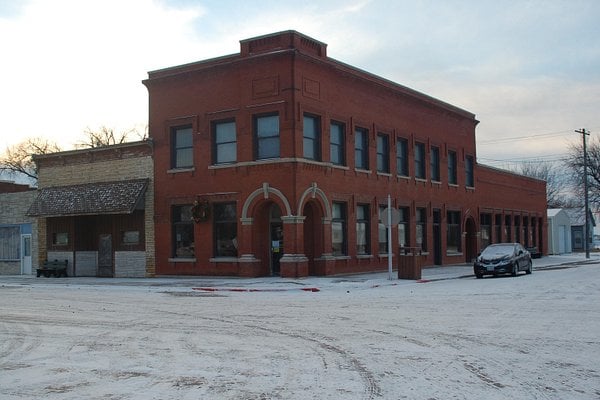
Nestled near the Nebraska border, Munden is the kind of place you don’t stumble upon—you seek it, or you’re born into its rhythm. With just a handful of streets and wide fields that stretch out like an endless quilt, it feels gently removed from the noise of the world.
There are no big signs or busy roads—just gravel lanes, old barns, and the kind of silence that lets you hear the wind change. The heart of town beats inside its tiny post office and occasional church potluck, where neighbors swap garden tips and stories.
Visitors might stop to see the historic schoolhouse, photograph rusted rail lines, or take a slow drive through farmland that hasn’t changed in decades. Farming is still the mainstay, handed down through generations with quiet pride. It’s the kind of town where time doesn’t press—you just live it, one honest day at a time.
Where is Munden?

Munden sits in north-central Kansas’s Republic County, surrounded by open plains and farmland. About 2½ miles from Belleville, it’s reached by quiet roads that stretch across wheat fields into a close-knit cluster of homes, a post office, and a community hall.
With fewer than 100 residents, the town feels still and self-contained. There’s no traffic, no rush—just prairie wind and quiet routines. It’s the kind of place where arrival feels intentional. Here, time moves as gently as the land itself.
24. Cedar
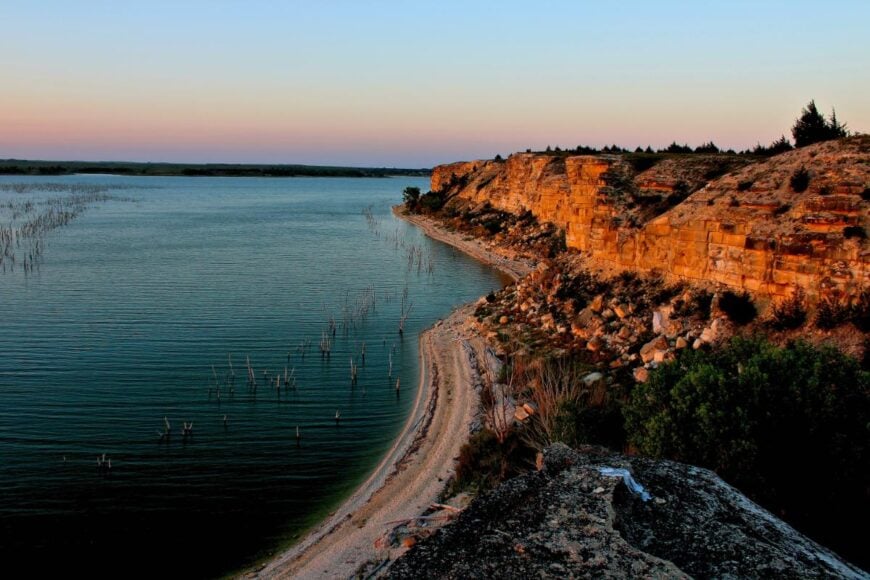
Cedar rests quietly on the edge of rolling farmland, with only a few homes, a church steeple, and the wind for company. Surrounded by wide stretches of prairie and miles from any major town, it feels more like a memory than a destination.
There’s no rush here—just dirt roads, sun-faded signs, and the hum of cicadas under open skies. You might explore the remains of an old schoolhouse, catch a glimpse of deer crossing a gravel path, or chat with one of the few longtime residents tending a garden or feeding hens.
Farming keeps the town alive, steady and unshaken. There are no attractions marked on maps—just space to breathe and think. It’s the kind of place that reminds you how quiet the world can be.
Where is Cedar?
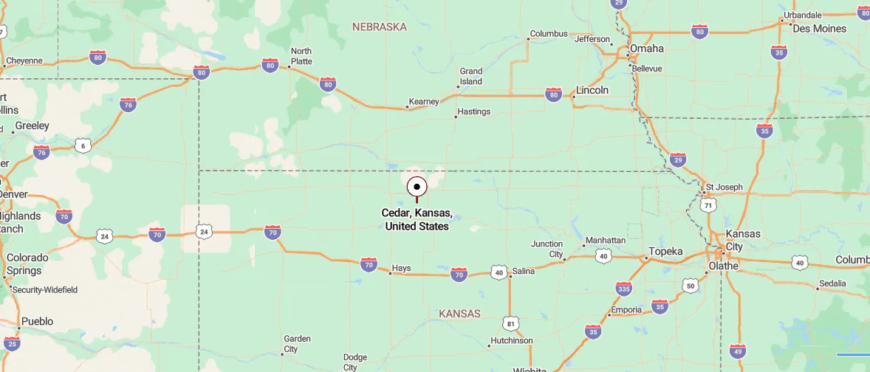
Cedar, Kansas, is a tiny former railroad town in Smith County, down to just 11 residents as of the 2020 census. It covers only 0.18 square miles and is reached via Highway 9 where quiet roads rimming open wheat fields lead you past an old grain elevator and the depot’s gazebo in Jim Lydic Memorial Park.
With no shops or services, the place feels paused between fields and wind‑curved horizons. The handful of homes and vacant lots are shaded by prairie sky and subtle absence. Silence here isn’t empty—it’s settled. Cedar feels not found, but intentionally remembered.
23. Portis
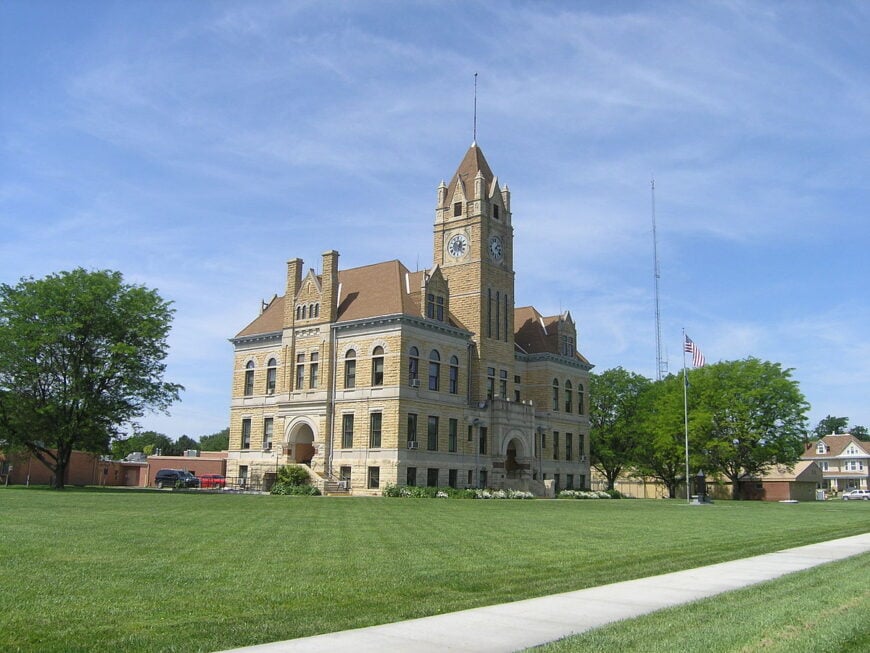
Portis sits low along the Saline River, tucked between quiet hills and forgotten highways. The town’s old stone buildings and wooden storefronts hint at a livelier past, but now the streets are mostly still, save for a tractor passing or kids riding bikes under cottonwoods.
Surrounded by open farmland and framed by the sky, it feels gently folded into the landscape, easy to miss and hard to forget. Visitors might stroll through the remnants of the old railroad depot, fish along the riverbanks, or stop at the local café where conversation comes slow and steady.
Farming is still the heartbeat here, along with the stories passed around at grain elevators and front porches. Time doesn’t push—people just live with it. It’s the kind of place that stays with you, long after you’ve left.
Where is Portis?

Portis sits in Osborne County, Kansas, along the north fork of the Solomon River, reached by Highway 9 and quiet farm lanes. With about 82 residents and no stores, it’s a quiet grid of homes, a post office, and a small park.
Grain silos and the old depot-turned-gazebo mark its modest past. The Limestone Porky Pig statue adds a touch of charm to the stillness. Fields stretch wide around town, and the river drifts slowly nearby. In Portis, time moves by the hush of land and sky.
22. Freeport
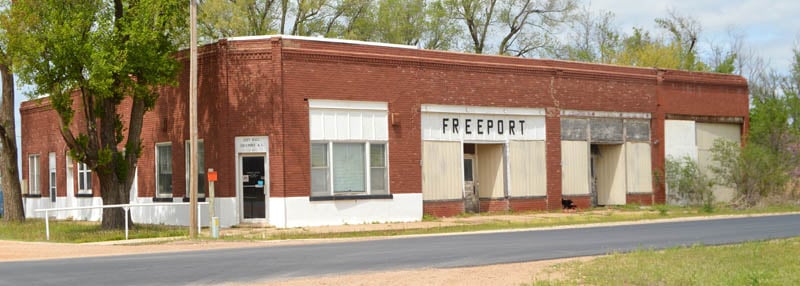
Freeport rests near the Oklahoma line, barely a blip on the map and often missed unless you’re looking. Once the smallest incorporated town in Kansas, its few remaining buildings stand like quiet sentinels of the past.
With no shops, no stoplights, and fields stretching out in every direction, it feels more like a whisper than a place. You might wander past the old church, walk the gravel roads, or sit under a wide sky that seems to go on forever.
Life here leans on farming, with just enough people to keep the rhythm going. There’s no schedule, no noise, just wind and memory. It’s the kind of place where the silence says more than words ever could.
Where is Freeport?
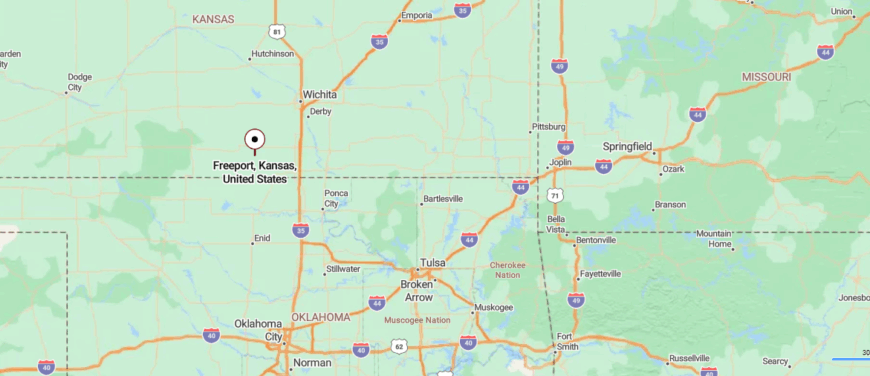
Freeport sits in Harper County, Kansas, now little more than a ghost town with just five residents before it dissolved in 2017. Reached by a quiet turnoff from Highway 160, it’s a grid of empty streets, a lone grain silo, and a scattering of weathered buildings.
Once a bustling rail town with hundreds of residents, its boom faded fast. Now, prairie grass grows where storefronts once stood. The silence feels thick, the past barely clinging to what’s left. Freeport is a memory held gently by the land.
21. Mildred
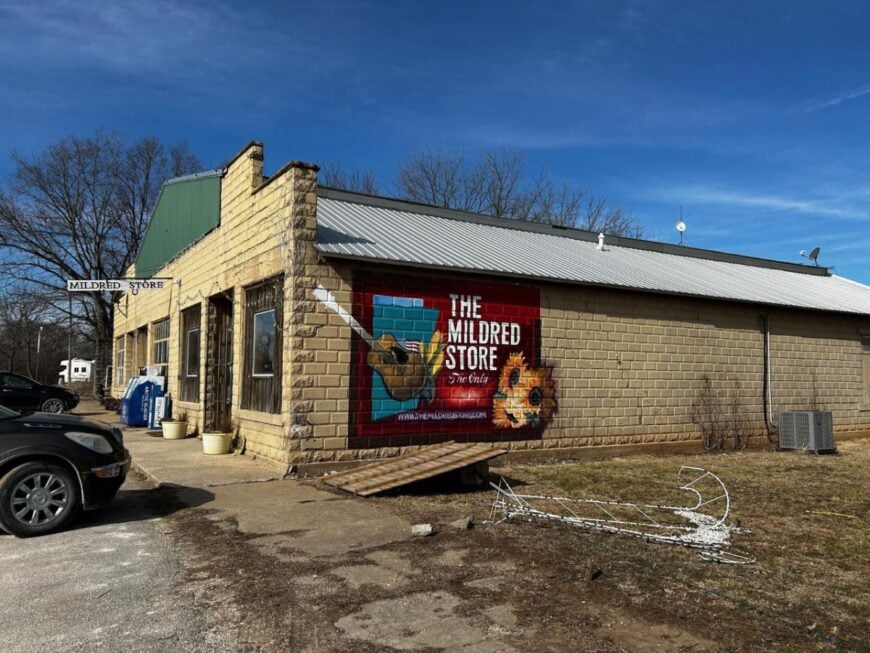
You won’t find Mildred on most road trip itineraries. It’s the kind of place where the road narrows, the noise fades, and the sky suddenly feels wider. A handful of buildings—some leaning with time—stand quietly beside fields that stretch like old stories passed down in rows.
There’s no rush here, just the scent of earth, the low hum of tractors, and the occasional laughter spilling from the historic Mildred Store, where music and chili dogs still bring neighbors together.
You might walk past the grain elevator, wave to someone rocking on a porch, or follow the same dirt path someone’s grandfather once did. Most who live here farm; those who visit often linger longer than planned. Mildred doesn’t call attention to itself. It simply waits—and welcomes—when you arrive.
Where is Mildred?
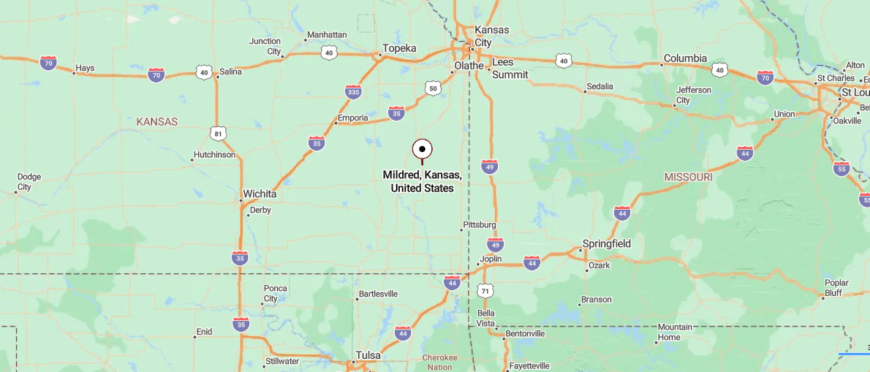
Mildred rests in Allen County, Kansas, about 7 miles north of Moran along U.S. Route 59, surrounded by open prairie. Once a booming cement town of 2,000, it now holds around 25 residents and a scattering of homes, a church, and Charlie Brown’s Market.
The old railroad tracks and cement ruins mark what once was. Quiet roads curve past empty structures and soft fields. The pace here is steady, the silence lasting. Mildred is a place held gently by time.
20. Denton
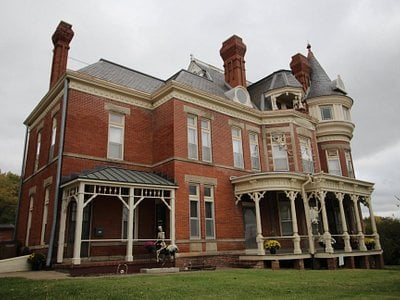
Denton rests quietly in the northeastern hills, just far enough from highways to feel forgotten and perfectly still. Surrounded by cornfields and long gravel roads, it sits in a pocket of calm where the loudest sounds are birdsong and the breeze through trees.
There’s a post office, a church, a scattering of homes—and not much else, unless you count the stories passed across fences and porches. Visitors might spot the old school, walk the empty streets, or drive slow just to take in the fields glowing gold at sunset.
Farming is the backbone, and time flows with the crops—steadily, without hurry. No crowds, no noise, no rush. It’s the kind of place where you hear yourself think—and maybe remember something you forgot you missed.
Where is Denton?
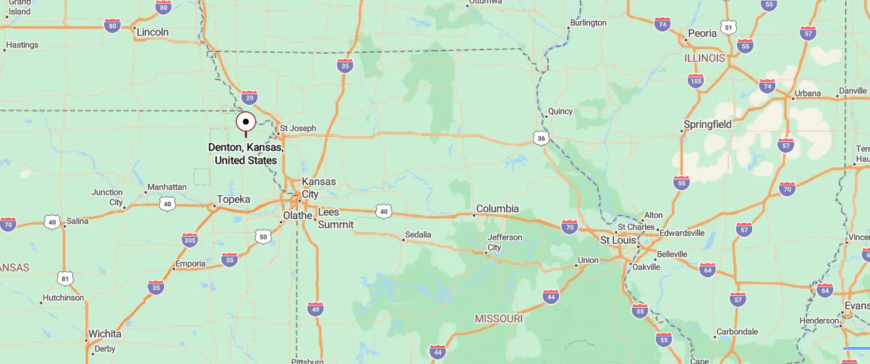
Denton sits in Doniphan County, Kansas, near the Missouri River and just off U.S. Highway 36, reached by winding rural roads. With around 130 residents and a footprint under 0.2 square miles, the town feels small and settled.
A post office, city hall, and a few homes form its quiet center. Open fields surround the town, stretching wide beneath the sky. Echoes of railroad days and old schoolhouses remain in spirit. Denton moves at the pace of wind and memory.
19. Bogue
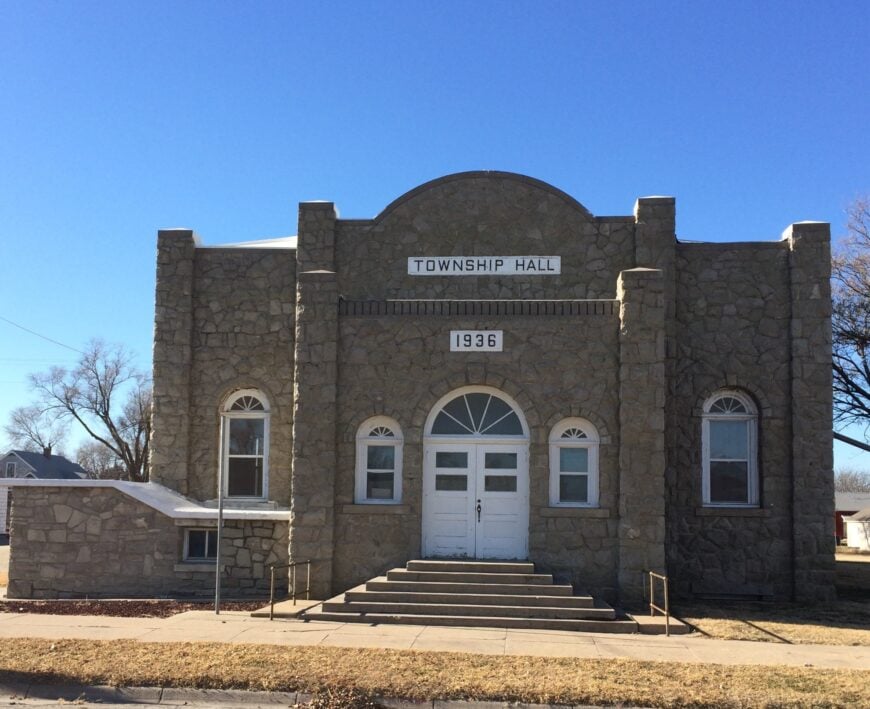
There’s a stretch of highway where, if you blink, you’ll miss the turnoff to Bogue. And maybe that’s the way it’s meant to be. Hidden in the wide quiet of western Kansas, this little town leans into the hush—surrounded by wheat fields, low hills, and skies that seem to go on forever.
The old schoolhouse stands like a memory, and the grain elevator still watches over it all. On warm evenings, you might find a neighbor mowing, a porch light flickering on, or the scent of cut hay in the air.
People here farm, mostly—living close to the land, close to each other. Visitors don’t come often, but when they do, they tend to stay a while. Bogue doesn’t need to announce itself—it’s enough just to be.
Where is Bogue?

Bogue sits in Graham County, Kansas, along the South Fork Solomon River, just off K-18 and U.S. 24. It’s reached by rural roads that pass wheat fields and old grain elevators before opening into town.
With about 150 residents and railroad roots dating back to 1888, Bogue feels steady and close-knit. A post office, a few homes, and quiet streets make up its core. The land stretches wide and flat beyond the town’s edge. In Bogue, the past lingers softly in the stillness.
18. Morland
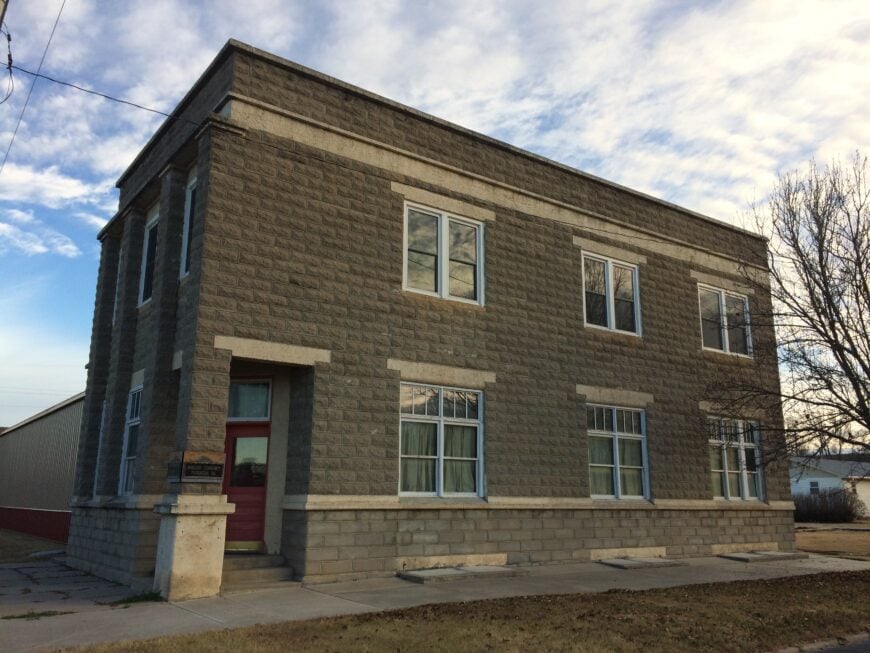
You’ve probably never heard of Morland. That’s alright—we like it that way. We’re set a ways off from the nearest highway, with more gravel than pavement, and the kind of silence you notice right away.
Mornings start slow here: a dog barking in the distance, someone waving from a pickup, the scent of fresh-cut alfalfa drifting in. There’s not much to “do” unless you count walking past the old train depot, fishing a nearby pond, or watching the horizon from your back porch.
Folks still work the land like their parents did—farming wheat, raising cattle, living close to what matters. No one’s trying to impress you. But if you stay long enough, you might understand why no one really leaves.
Where is Morland?
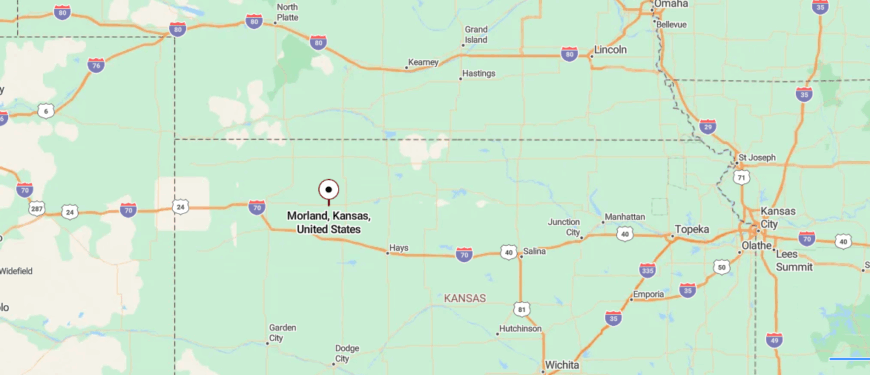
Morland is tucked in northern Graham County, Kansas, just off Highway 125 and surrounded by open prairie. With just over 100 residents across less than half a square mile, it feels quiet and close-knit.
Once a railroad town founded in 1884, its roots still show in old civic buildings and long stretches of field. A post office and community hall sit at the center of its small grid. Beyond that, it’s wheat, sky, and time moving slow. In Morland, stillness isn’t rare—it’s the rhythm.
17. Ramona
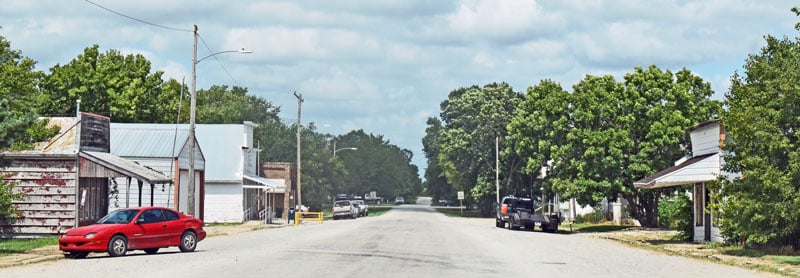
Ramona feels more like a memory than a map dot—set along a sleepy stretch of Marion County, where the roads narrow and the prairie reclaims the edges. Once a bustling railroad town, it’s now a quiet cluster of buildings wrapped in wide skies and the sound of wind brushing tall grass.
You’ll find handmade signs, gardens planted with care, and perhaps a festival poster still fluttering from last summer’s 4th of July. Stop in at the community center for a pie auction or follow the scent of barbecue drifting from a backyard gathering.
There’s no rush, just rhythm—set by sunrise chores and evening chats. Most folks farm, a few are retired, and everyone seems to have time to talk. Ramona doesn’t shout; it smiles. And if you stay long enough, you’ll start waving to everyone too.
Where is Ramona?
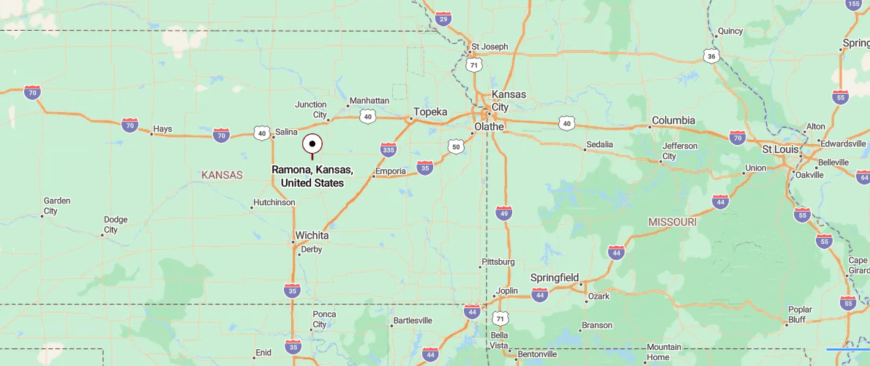
Ramona lies in Marion County, Kansas, just southwest of Herington, surrounded by Flint Hills prairie and reached by quiet county roads. Once a Rock Island Railroad stop, its rail history still lingers beside a small grid of homes.
With just 78 residents, the town moves at a calm, familiar pace. A church, post office, and old grain elevator anchor its center. Faded buildings hint at deeper roots. In Ramona, time rests easy under the open sky.
16. McDonald

Out near the Colorado line, where Kansas leans into open sky, McDonald waits quietly—nearly hidden in the westernmost folds of the state. There’s a kind of stillness here that feels deliberate, with long streets that end in wheat fields and silos standing like watchtowers.
Life hums at a gentle pace: grain trucks rumble past, porch flags flutter, and neighbors swap greetings from across tidy yards. You won’t find attractions in the usual sense, but you might catch a little league game, wander past the century-old schoolhouse, or sit beneath the stars without a single sound but crickets.
Agriculture is the backbone, but community is the soul. There’s something grounding about the way time lingers in McDonald. It’s not a town you pass through—it’s one you quietly remember.
Where is McDonald?
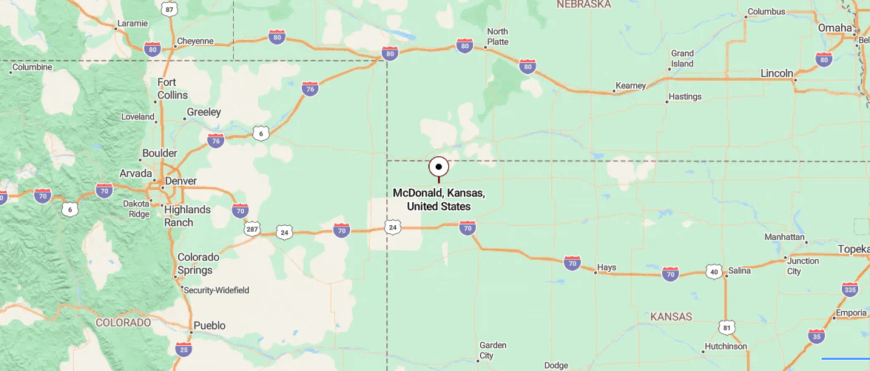
McDonald sits in Rawlins County, northwest Kansas, surrounded by open prairie and reached by quiet rural roads. With just over 100 residents in a small grid, the town feels steady and deeply rooted.
A grain elevator and old depot recall its railroad past, while a post office and scattered homes mark its modest heart. There are no shops—just fields and sky beyond the edge. The pace here is slow, the silence lasting. McDonald offers a quiet that feels earned.
15. Broughton
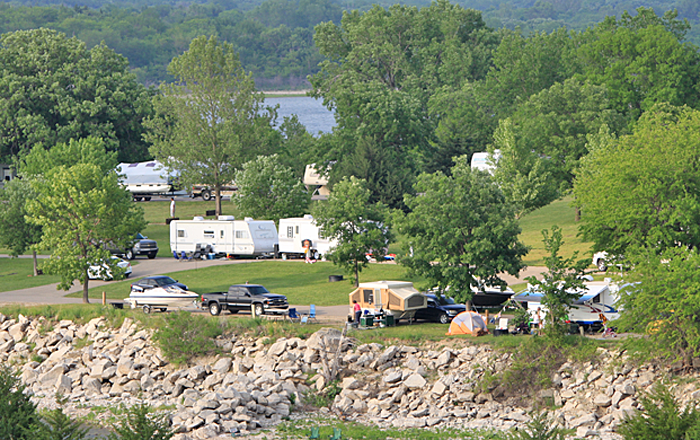
Broughton is more echo than town now—buried beneath the surface of time and the waters of Milford Lake. Once a small railroad community tucked along the Republican River, it vanished in the 1960s when the land was flooded for the reservoir.
There are no stoplights, no diners, no post office—only fragments: a stone foundation in the woods, an old road that leads to nowhere, a name on a map that no longer marks a place.
Kayakers paddle over what used to be streets, and hikers pass nearby, unaware of what rests below. The story lives on through local memory and scattered photos in museum archives. There’s no economy, no bustle—just silence and water and ghosts of home. Broughton isn’t just secluded; it’s gone—but not forgotten.
Where is Broughton?
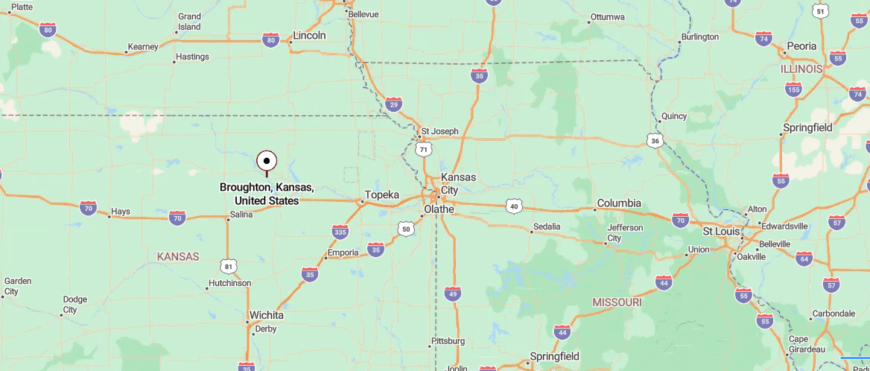
Broughton, Kansas lies in the north-central part of the state, nestled near the Republican River and surrounded by open plains. It’s about 40 miles northwest of Junction City—take U.S. Route 77 north, then turn west onto County Road 470 toward the Milford Lake shore.
The drive winds through farmland until you arrive at the site of the old town beneath the water.
14. Radium
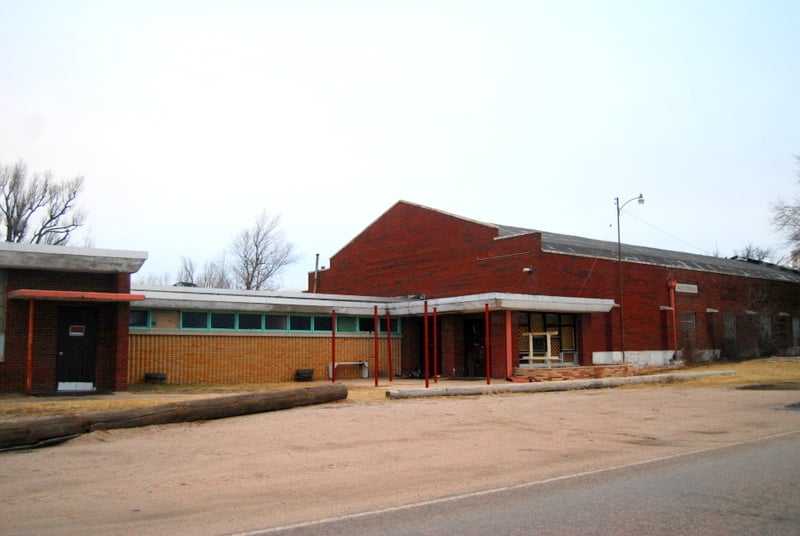
Radium rests gently on the plains, far from highways and big towns, with fewer than fifty people calling it home. The old rail lines no longer carry trains, and the grain elevator now towers quietly over a scattering of weathered homes and open lots.
It feels like a place held in stillness—where the sky stretches wide, and even the wind moves slow. You might walk past the one-room church, explore nearby country roads on foot or bike, or catch the late summer harvest glow rolling over the wheat fields.
A few locals still farm the land, carrying on traditions that go back generations. There’s no rush, no attractions marked on maps—just a rhythm that runs deep and steady. The silence here isn’t emptiness—it’s peace. It’s the kind of place that reminds you how quiet the world can be.
Where is Radium?
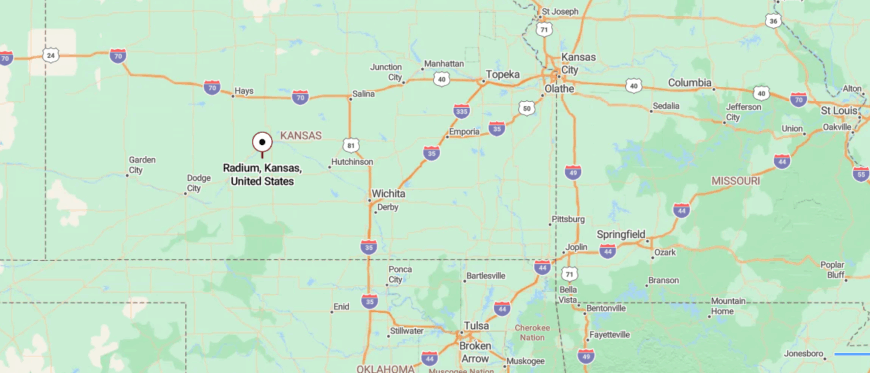
Radium, Kansas rests in the central part of the state, tucked among the flat, wind-swept fields of Stafford County. It’s located about 25 miles southwest of Great Bend, accessible by a series of quiet county roads branching off U.S. Route 281.
The route rolls past open farmland, grain silos, and stretches of prairie with few signs to mark your way. Out here, the horizon feels endless—and the quiet settles in like a second sky.
13. Virgil
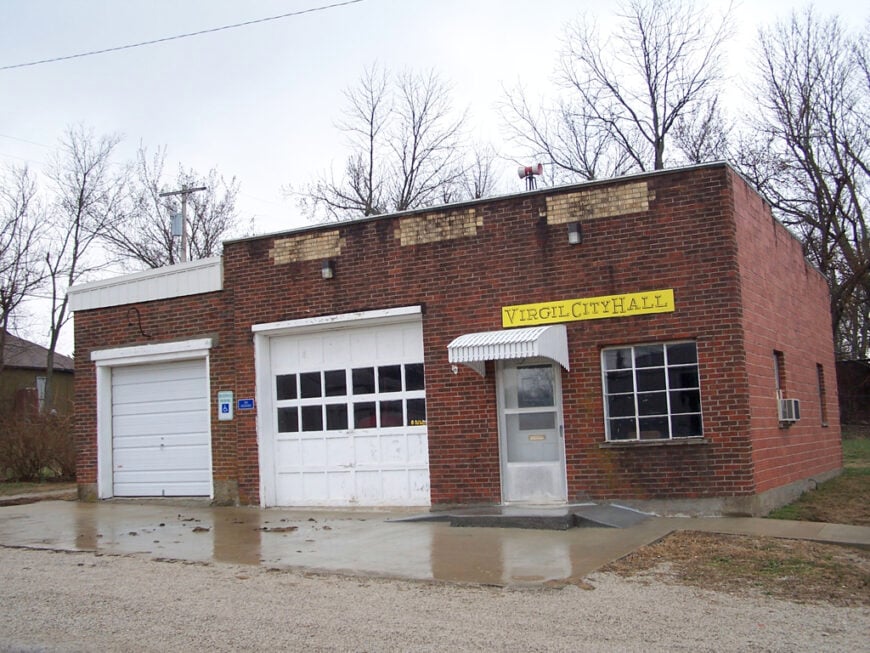
Set deep in the Flint Hills, Virgil drifts just off the edge of memory—small, nearly hidden, and surrounded by rolling wild. With a population barely in double digits and miles of pastureland in every direction, it feels disconnected from modern pace.
There’s no fast traffic here, just gravel roads winding past old barns, quiet creeks, and fields glowing gold in late light. Visitors might admire the historic church, walk near the Verdigris River, or catch the Virgil Rodeo if the timing’s right.
Most who remain work the land or have settled into retirement, tending gardens and porches alike. Life hums low and steady, marked more by seasons than schedules. In Virgil, time stretches like the hills themselves.
Where is Virgil?
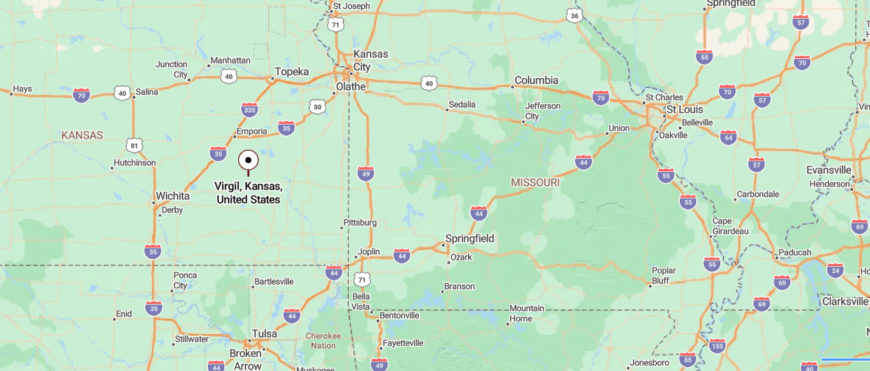
Virgil, Kansas is nestled in the rolling Flint Hills of eastern Kansas, where the land begins to ripple with gentle rises. It sits about 30 miles southeast of Emporia, reached by turning off U.S. Route 54 and following a quiet stretch of two-lane road through pastureland.
The drive winds through grazing fields and pockets of woodland, with little traffic and long views. It’s a place where the hills hush the noise, and the world feels far away.
12. Zurich
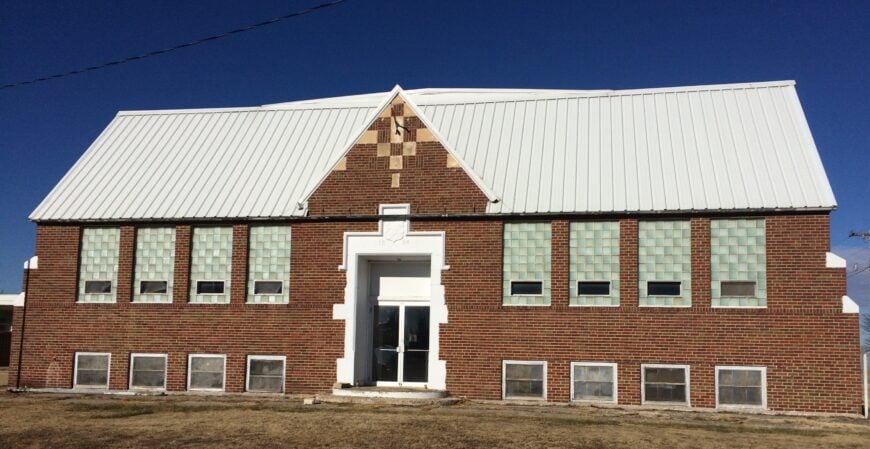
Tucked deep in Rooks County, Zurich lies far from major roads, surrounded by quiet farmland and the kind of silence that stretches for miles. The town’s small cluster of buildings—church, grain elevator, and a few homes—feel more like echoes than destinations.
Gravel streets wind past the old schoolhouse and faded signs that hint at busier days. Visitors might photograph the vintage storefronts, walk the edge of golden wheat fields, or explore a nearby creek on foot.
Farming still anchors daily life, passed down through generations without rush or change. It’s rustic, hushed, and honest—where days feel long and simple by design. You won’t find crowds or traffic, just space, sky, and stillness. It’s the kind of place that reminds you how little you really need to feel at peace.
Where is Zurich?
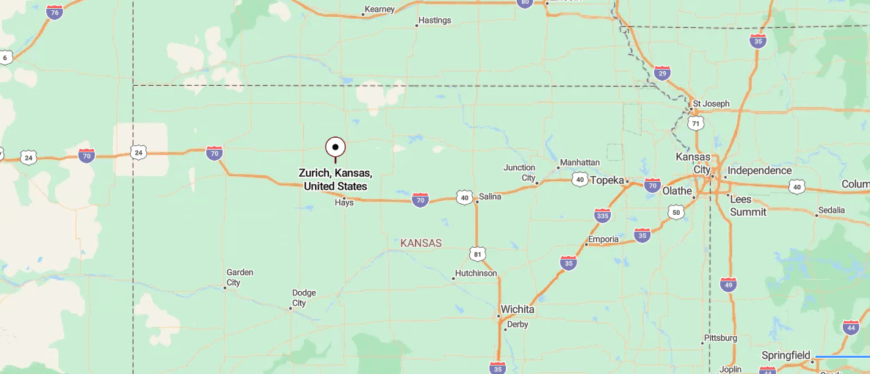
Zurich, Kansas lies in the northwestern part of the state, surrounded by wide-open farmland in Rooks County. It’s about 25 miles northwest of Hays, reached by a turn off U.S. Route 183 onto a series of quiet local roads.
The journey passes through wheat fields and skies that seem to go on forever, with few towns along the way. It’s the kind of place where the silence settles in, and everything moves a little slower.
11. Ransom
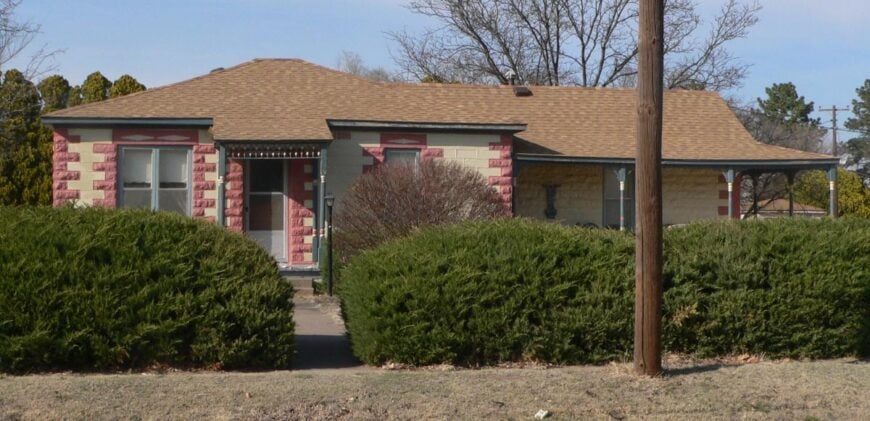
Ransom rests in the open expanse of Ness County, far from interstates and tucked between long stretches of prairie and sky. With fewer than 300 residents and a downtown that moves at the pace of conversation, it feels like time passes differently here.
The streets are wide and quiet, lined with historic brick buildings, a tiny library, and benches that catch the afternoon sun. Visitors might browse the local antique shop, stroll through the city park, watch a high school ballgame under the lights, or explore nearby walking trails that wind past wheat fields.
Agriculture remains the lifeblood—farming, ranching, and small-town grit keeping the rhythm steady. The town carries a gentle, lived-in charm, where everyone waves and nothing feels rushed. It’s quiet, familiar, and a little like stepping into a slower world. It’s the kind of place that reminds you how peaceful ordinary can be.
Where is Ransom?
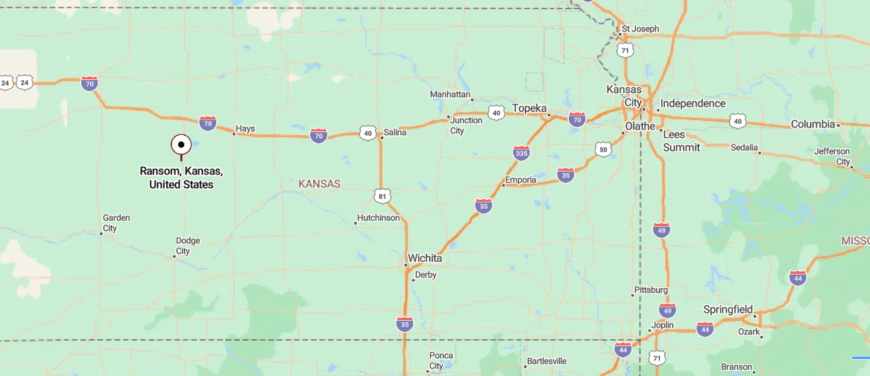
Ransom, Kansas sits in the high plains of west-central Kansas, tucked into the quiet expanse of Ness County. It’s located about 40 miles southwest of Hays, accessible via U.S. Route 283 and a short drive along a rural highway.
The road stretches through open farmland and gently rising fields, with little more than grain elevators marking the way. Out here, the sky feels bigger, and the stillness wraps around you like a pause in time.
10. White Cloud
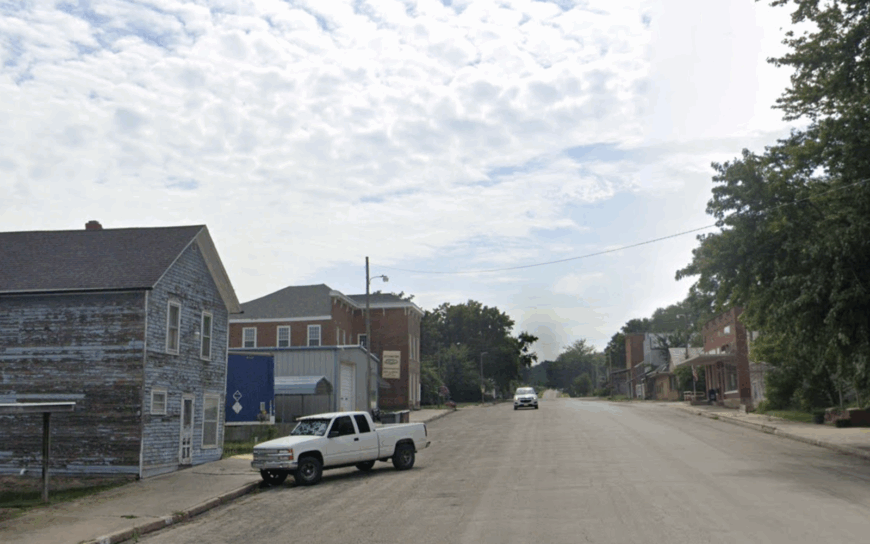
Roughly 115 people call White Cloud home, a place where crumbling red-brick storefronts perch high above a sweeping bend of the Missouri River. Visitors spend lazy afternoons at the Four State Lookout, a bluff-top platform where, on a clear day, we can pick out Kansas, Missouri, Nebraska, and Iowa all at once.
Farming and a small amount of river tourism provide the town’s modest income, with harvest trucks rumbling along Main Street in autumn. The absence of chain stores, traffic lights, and even a gas station underscores how little outside activity reaches the ridge.
After dusk, only the river and the wind break the stillness, reinforcing its seclusion. Historic murals tucked along the storefronts offer a hidden gem for photographers chasing Midwest nostalgia.
Where is White Cloud?
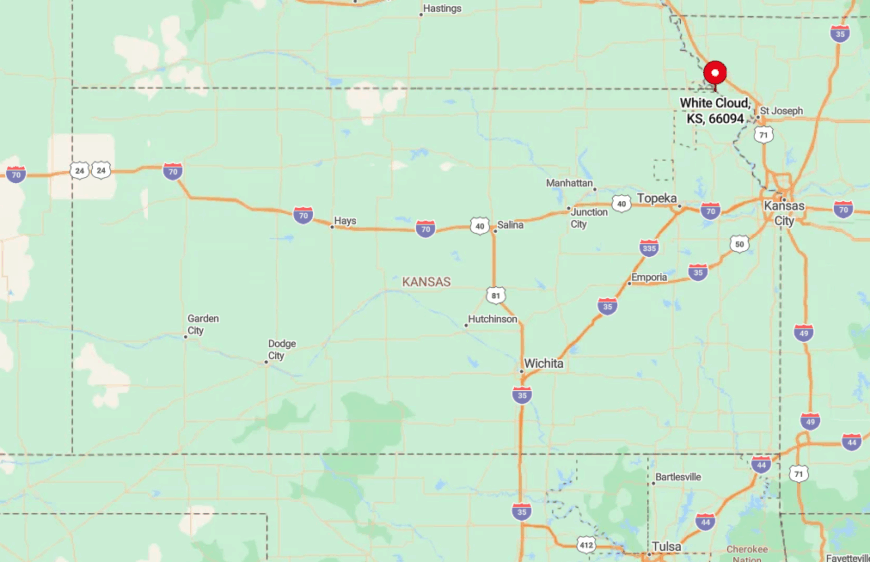
White Cloud sits in Doniphan County at the far northeast corner of Kansas, about 20 miles north of Atchison on K-7. It clings to limestone bluffs that rise sharply above the river, leaving only one paved route in and limiting through traffic.
The nearest interstate lies more than 40 minutes away, and spring floods sometimes narrow the approach roads even further. Those willing to wander the extra miles are rewarded with postcard views uncluttered by crowds.
9. Muscotah
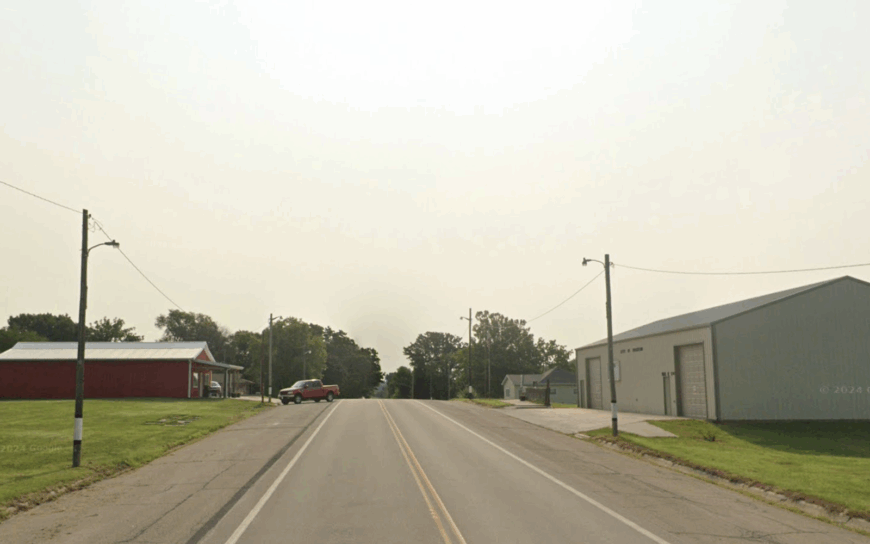
Muscotah’s 170 residents wake up beneath a giant white water tower shaped like a baseball, a playful nod to native son and Hall of Fame shortstop Joe Tinker. Travelers can tour the tiny Joe Tinker Museum in the old library, photograph the quirky tower, then stroll grain-lined streets that smell of fresh wheat in June.
Agriculture dominates the local economy, with elevators and farm-supply shops serving the surrounding prairie. A lone café and a seasonal produce stand supply most services, while larger errands require a half-hour drive.
The settlement’s quiet stems from its distance to interstates and the fact that trains no longer stop here, leaving evenings filled mostly with meadowlark song. Sunrise walks along the prairie edge reveal wildflowers few outsiders ever notice.
Where is Muscotah?
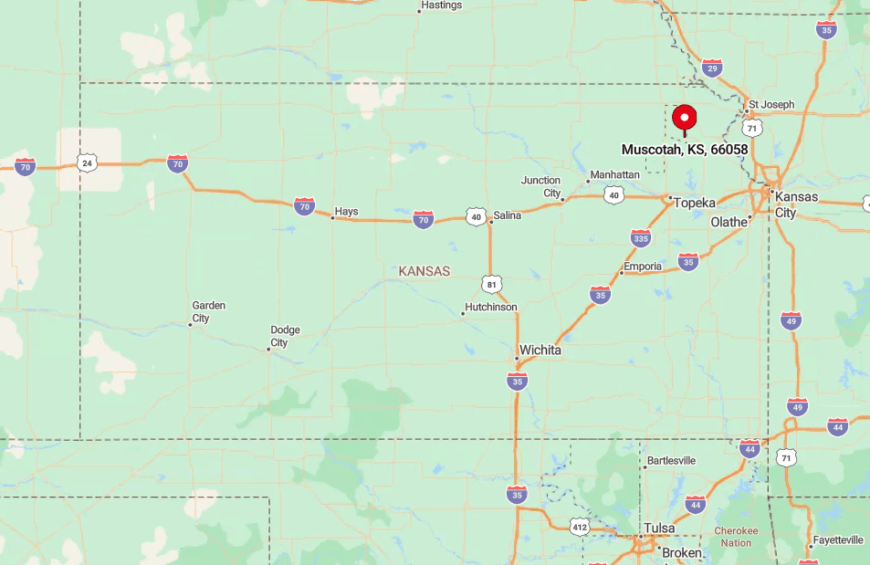
The town rests along US-159 in Atchison County, but tallgrass fields quickly swallow the highway in either direction. Long stretches without cross streets keep traffic light, emphasizing the hamlet’s tucked-away feel.
The nearest larger town, Holton, is 15 miles west across rolling cropland. Most visitors arrive by two-lane blacktop, the perfect pace for spotting hawks perched on fence posts.
8. Goff
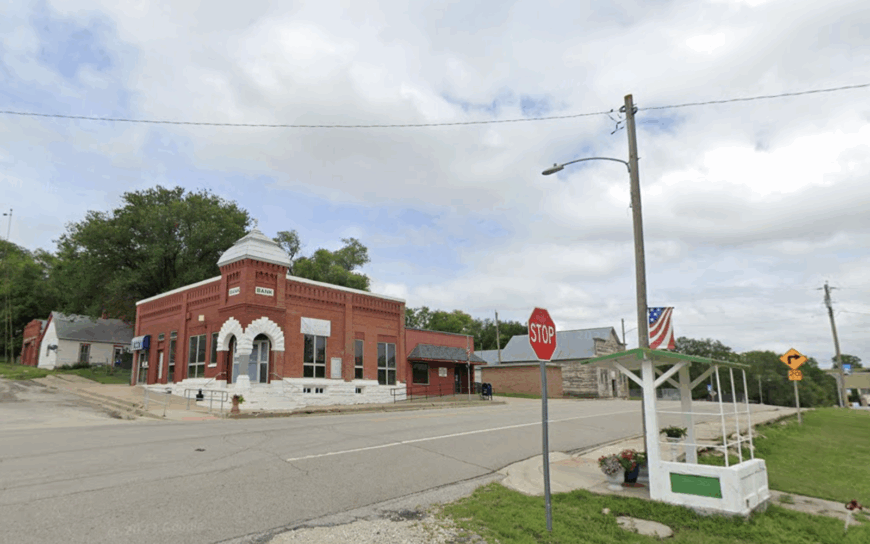
Goff, with just over 100 residents, centers on a single block of Main Street where an ivy-draped 1905 bank building stands empty yet photogenic. Antique hunters poke through sheds behind homes, birders roam the Nemaha River corridor, and locals gather for community suppers in the old fire hall.
Grain and cattle still underpin the economy, though many residents commute to Seneca for work. Seclusion sets in after 5 p.m. when pickup trucks head for gravel roads, leaving Main Street hushed.
Flickering streetlights and the mournful whistle of a distant train accentuate the feeling that time has paused. A little-known treat is the annual fall chili cook-off held next to that abandoned bank, drawing cooks from across the county.
Where is Goff?
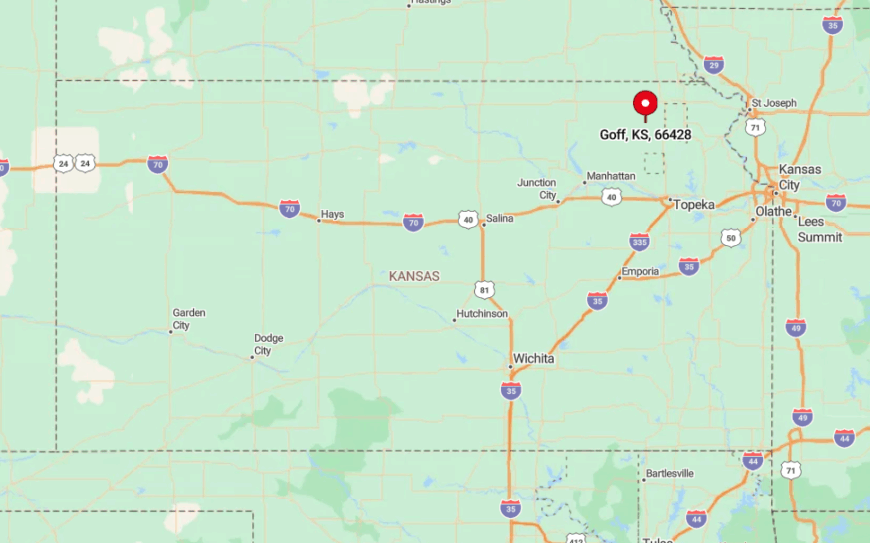
The village lies in Nemaha County five miles south of K-9, a state highway that itself feels remote. Dense oak groves shield the town from passing eyes, and rail service ceased decades ago.
Reaching Goff means threading a network of gravel roads that see more tractors than sedans. Those last bumpy miles guarantee only intentional travelers make the trip.
7. Vermillion
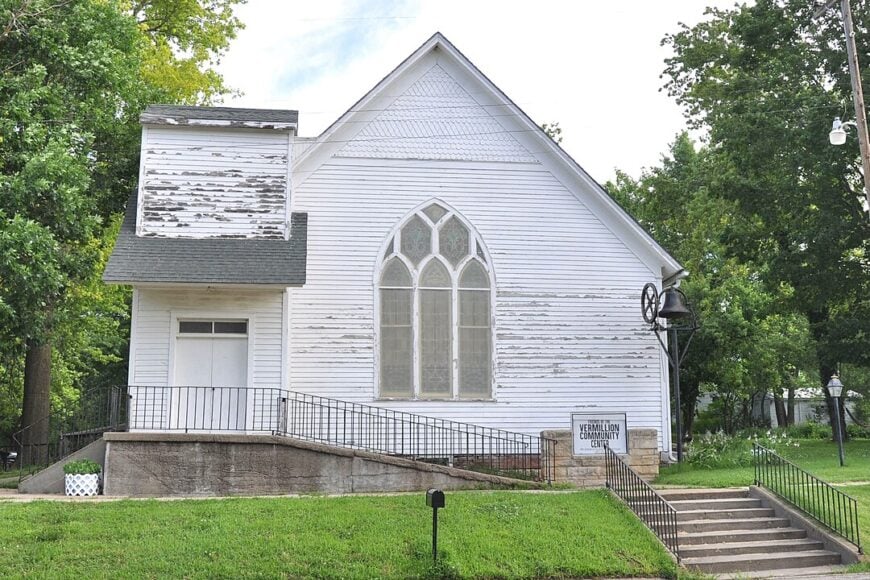
Home to about 80 people, Vermillion greets visitors with a lone stone post office and a weathered grain elevator set against the boundless Flint Hills. Daytime activities revolve around bird-watching, wildflower photography, and the simple pleasure of prairie drives where cattle outnumber cars.
Cow-calf operations and hay production anchor the local economy, supported by a cooperative that opens just three days a week. Because the Flint Hills remain largely unplowed, few roads slice through, letting quiet reign.
At night, stars explode overhead thanks to negligible light pollution. A rarely noticed treasure is the 1893 Vermillion School, now a community hall filled with pressed-tin ceilings and century-old desks.
Where is Vermillion?
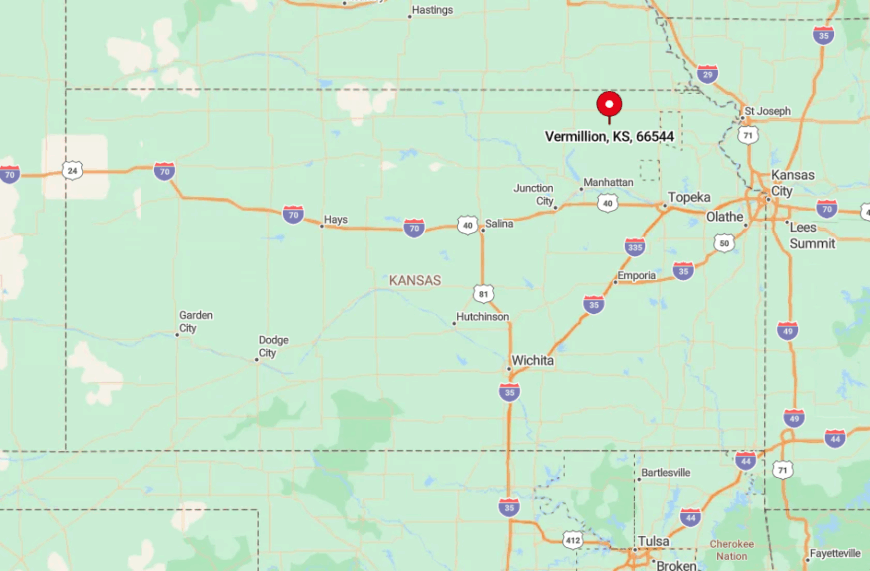
Vermillion sits in southern Marshall County, roughly 20 miles south of US-36 and seven miles from the nearest gas pump. It occupies a shallow valley surrounded by tallgrass, with only one paved route connecting it to the wider world.
Spring burns often close side roads, heightening its isolation. Most travelers arrive by KS-99, then meander west on county blacktop until the prairie finally reveals the town.
6. Emmett
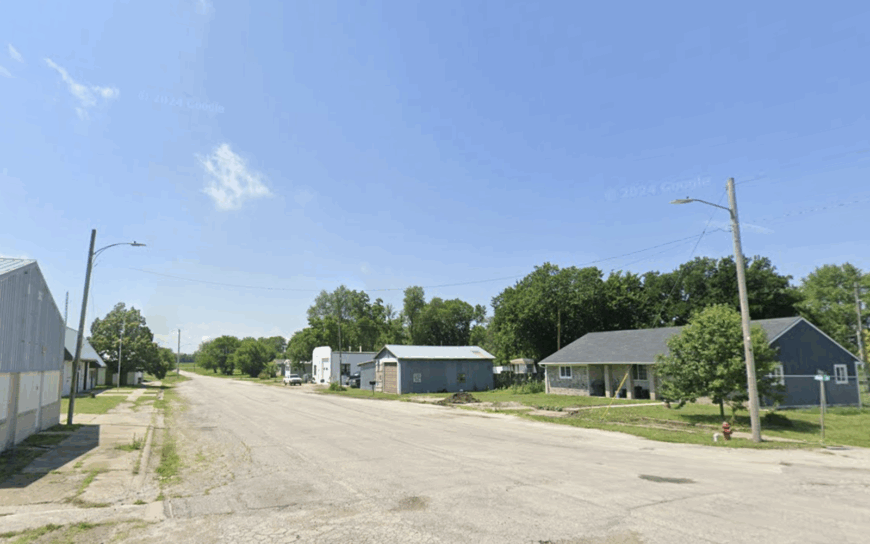
Emmett’s population hovers near 180, and its skyline is dominated by a century-old limestone church rising from gently rolling rangeland. Anglers test their luck on nearby Cross Creek, while cyclists favor the traffic-free county roads that unspool beneath endless skies.
Cattle ranching and small-grain farming remain the chief livelihoods, supplemented by seasonal custom harvesting crews. Because the town sits several miles off both US-24 and I-70, few visitors stumble upon it unintentionally.
After sunset, gravel roads reflect only moonlight, and the steady hum of crickets becomes the loudest sound in town. The church basement’s monthly kolache sale, advertised only on a chalkboard out front, rewards those who show up early.
Where is Emmett?

Nested in Pottawatomie County, Emmett lies ten miles west of St. Marys along K-63, a two-lane road that winds through pastureland. Hills buffer the village from highway noise and funnel most travelers toward larger towns.
Absence of rail service and limited cell coverage deepen the sense of being off the grid. Drivers who make the trek find parking easy: Main Street can handle the entire population with spaces to spare.
5. Soldier
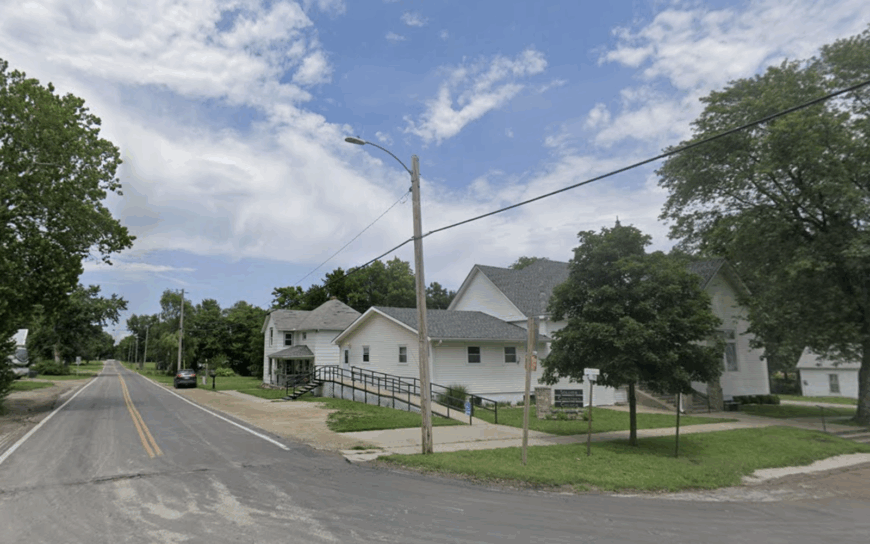
Roughly 104 residents wake before dawn to the silhouette of a towering wooden grain elevator that defines Soldier’s faint skyline. Photographers line up at sunrise for shots of the structure glowing against pastel skies, then head to Banner Creek Reservoir for kayaking or shoreline hikes.
Corn and soybean fields bankroll the local economy, and a compact feed store doubles as the town’s social hub. Soldier rests far from retail corridors, and the single café closes by two in the afternoon, letting prairie silence settle early.
Evenings showcase whip-poor-will calls and the flash of fireflies in vacant lots. The 1917 Soldier Schoolhouse, now a private residence occasionally opened for historical tours, offers a quiet surprise to architecture buffs.
Where is Soldier?

The town sits in north-central Jackson County along K-62, a highway lightly traveled outside harvest season. Its position atop a ridge leaves cellphone signals faint and radio stations elusive.
Detouring traffic rarely appears because larger routes lie 15 miles east and west. Visitors generally arrive via Holton, then watch pavement turn to gravel just before they crest the hill into Soldier.
4. Leona
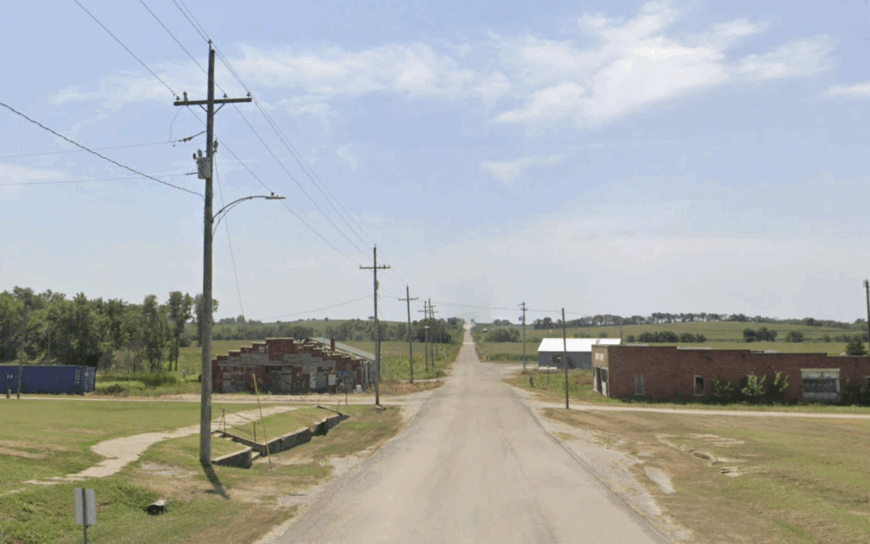
Fewer than 50 people inhabit Leona, nestled in a Missouri River bottom where a rusting steel truss bridge guards the southern approach. Adventurous travelers paddle quiet sloughs, comb cottonwood groves for morel mushrooms, and photograph century-old tombstones in a tiny hilltop cemetery.
Row-crop farming and a grain-drying operation represent the bulk of the local economy, though many residents supplement income with seasonal river work. Flood-prone roads and the absence of streetlights make the hamlet feel cut off, especially after heavy rains.
Once the sun dips, only frogs and cicadas break the near-total hush. A seldom-marked path off the levee leads to an abandoned ferry landing, perfect for sunset picnics.
Where is Leona?
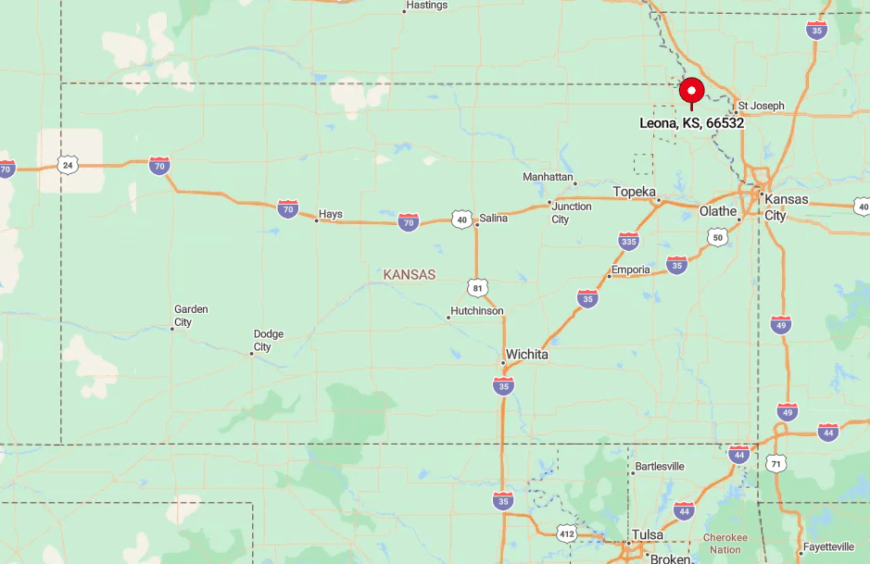
Located in Doniphan County six miles east of US-73, Leona hides behind levees and dense tree lines. Approaches are gravel, and spring flooding can close the old truss bridge that provides the most direct access.
Rail service ended in the 1980s, and GPS signals fade among the cottonwoods, so paper maps help. Those who persist are rewarded with riverbank solitude and plenty of skipping stones.
3. Circleville
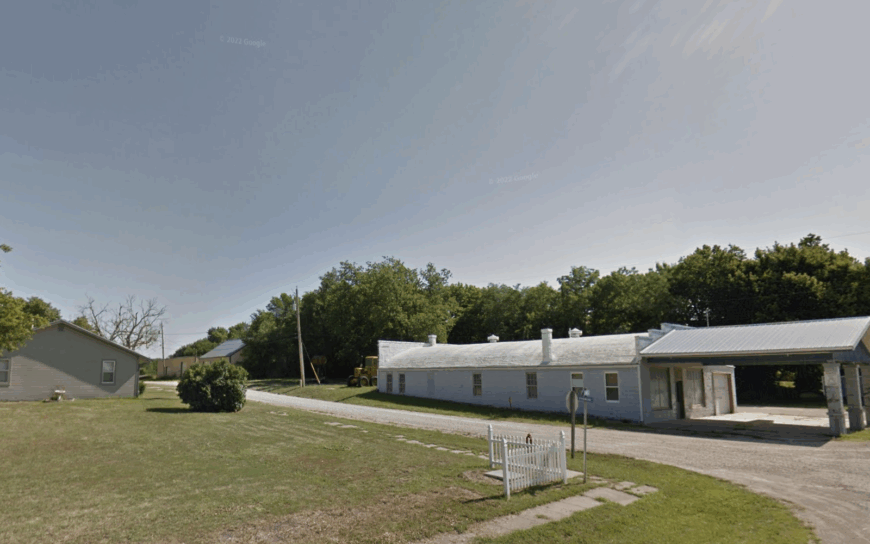
Circleville’s 160 residents live among classic red barns and late-summer sunflower fields that seem to stretch forever. Visitors stop for scratch-made pies at the Circleville Café, then wander gravel lanes in search of vibrant barn quilts painted on outbuildings.
Farming, especially sunflowers and soybeans, fuels the local economy, while several artisans sell quilts and woodcrafts from home workshops. Because larger highways arc well to the south and west, traffic barely trickles through town.
Night skies reveal a spray of stars bright enough to cast faint shadows on the dusty streets. Locals quietly pride themselves on their hidden walking trail, a mowed path along Elk Creek marked only by a mailbox-turned-trailhead register.
Where is Circleville?
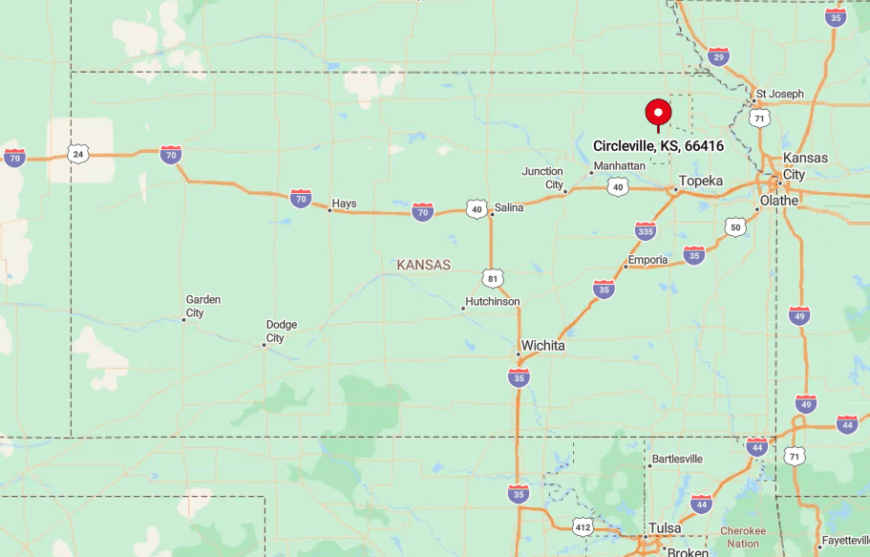
Sitting in Jackson County nine miles north of Holton, Circleville is reachable by K-79, a route bypassed by most through travelers. Shelterbelts of tall cedars hide the town until the last quarter mile, preserving its sense of surprise.
No bus routes or rail lines serve the area, funneling visitors onto two-lane country roads. The final approach rewards drivers with sweeping views of sunflower fields that give the community its warm glow.
2. Randolph
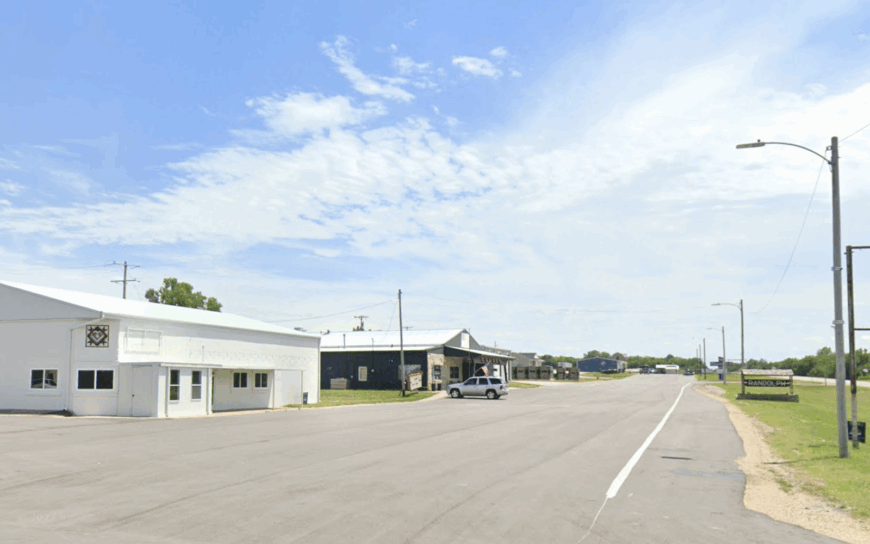
Randolph’s current population hovers around 170, gathered on a hill above Tuttle Creek Lake while stone ruins of the original town linger underwater below. Families picnic by old foundations in the Randolph State Park, anglers cast for crappie, and hikers trace the Blue River Trail that threads wooded coves.
Farming and lakeside recreation supply most jobs, with a small marina offering boat rentals and bait. Seclusion comes from being tucked up a peninsula where only one road enters and ends, eliminating any chance of through traffic.
Evening breezes carry nothing but water lapping against rocks and distant coyote calls. A seldom-visited gem is the “Schoolhouse Rock” viewpoint, a high perch revealing both the new and drowned town sites side by side.
Where is Randolph?
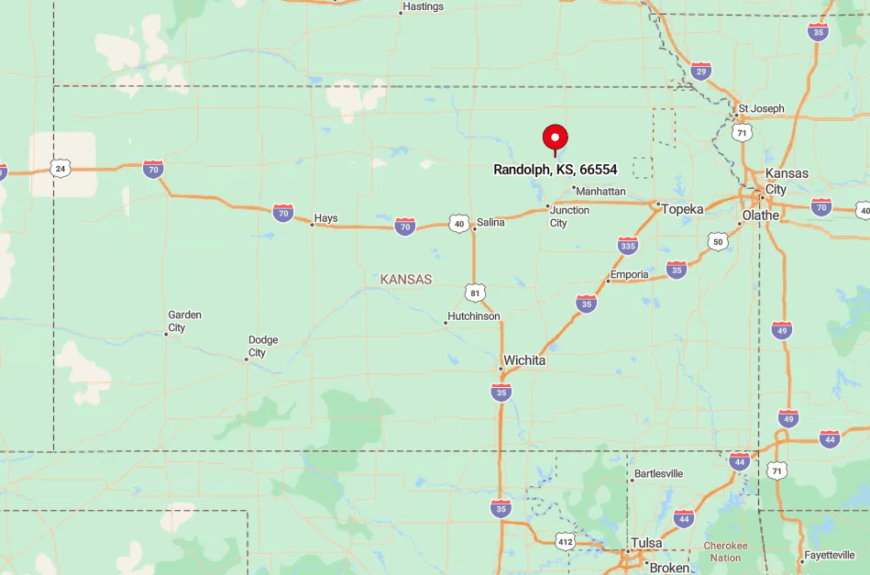
The town lies in Riley County 25 miles north of Manhattan via US-77, then east on KS-16 across the Tuttle Creek Dam. Because the lake wraps around three sides, Randolph feels like an island in prairie waters.
Public transit stops short of the dam, leaving private vehicles as the only practical way in. Once past the causeway, visitors find themselves at the road’s end with lake breezes and broad horizons for company.
1. St. Benedict
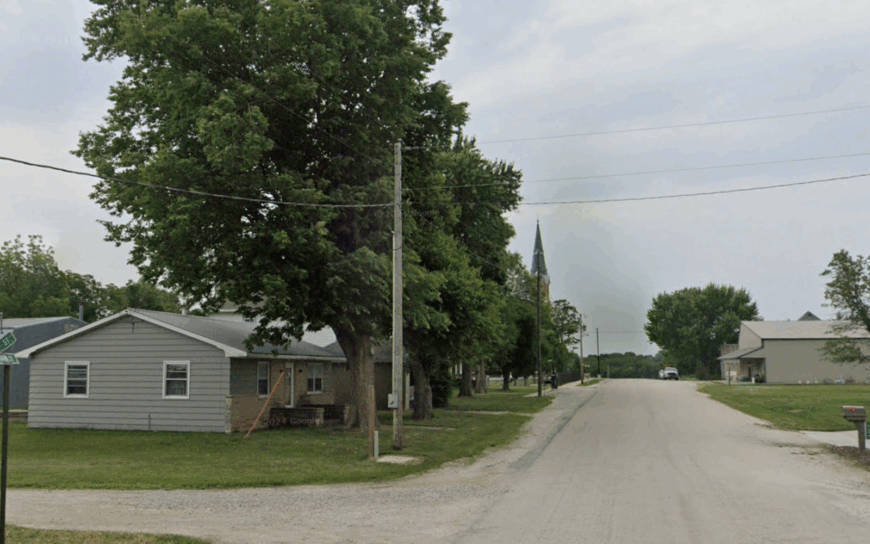
About 75 residents live in the shadow of St. Mary’s Church, a twin-spired Neo-Gothic landmark rising from seas of corn. Travelers admire 100-year-old stained glass imported from Munich, stroll a manicured prayer garden, and catch summer evening softball games on the church diamond.
Local income flows from grain farming and a handful of specialty livestock operations, with parish festivals supplying an annual economic boost. Seclusion stems from the fact that St. Benedict is unincorporated, lacks retail businesses, and sits five miles off the nearest state highway, leaving pews and porches equally quiet.
After dusk, the illuminated spires serve as the only beacon across the dark fields. Weekly self-guided tours, advertised solely on the parish website, reveal hidden hand-painted frescoes in the choir loft that many Kansans have never seen.
Where is St. Benedict?
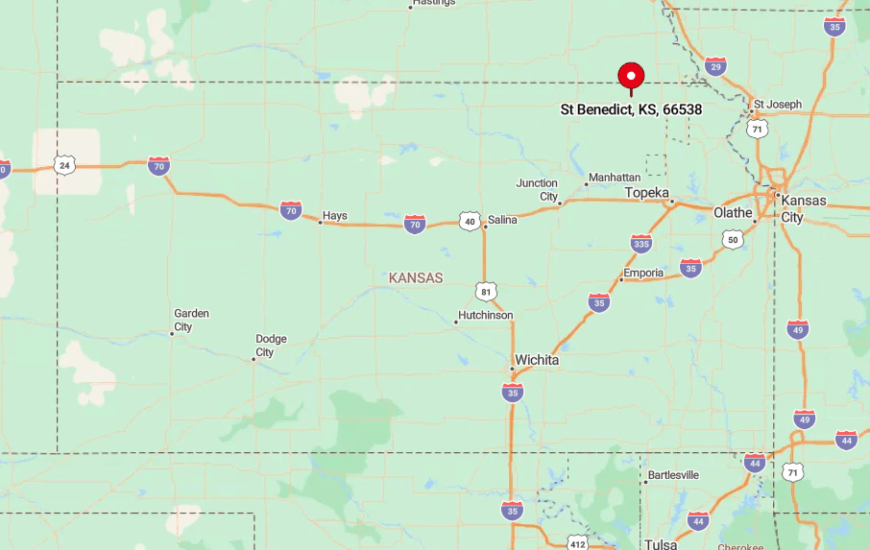
St. Benedict occupies a lonely patch of Nemaha County, five miles west of Seneca along winding county Route 176. Cornfields and shelterbelts absorb nearly all sound, and gravel detours make the last mile especially slow.
No public transport reaches the settlement, and the closest bus stop is in Topeka, more than an hour away. Visitors who crest the final hill see the spires first, a silent welcome to one of Kansas’s most peaceful corners.






